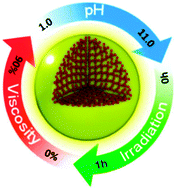Multi-stable fluorescent silica nanoparticles obtained from in situ doping with aggregation-induced emission molecules†
Abstract
Microenvironment in biology is diverse and complex which has been a great challenge for in vivo imaging materials, and so materials with environmental tolerance and photostability need to be explored. For aggregation-induced emission (AIE) molecules, the fluorescence is closely related to the restricted structure which is directly affected by the microenvironment. Inorganic silica nanoparticles can provide a rigid microenvironment which can stabilize AIE molecules to obtain fluorescent materials with environmental tolerance. Here, stable fluorescent SiO2 nanoparticles (CWQ-11@SiO2 NPs) have been prepared by doping with typical AIE molecules named CWQ-11. CWQ-11@SiO2 NPs have narrow size distribution and spherical morphology with a size of around 50 nm. The fluorescence intensity of CWQ-11@SiO2 NPs is nearly 45.4 times higher than that of free CWQ-11. CWQ-11@SiO2 NPs maintain excellent fluorescence stabilities under various conditions, such as in solutions with different pH values, different viscosities, or continuous irradiation, and even in simulated gastric fluid (SGF). Cellular imaging research represents efficient imaging ability of CWQ-11@SiO2 NPs in two different tumor cells including MCF-7S and HepG-2. All these results demonstrate that the CWQ-11@SiO2 NPs have been successfully prepared and remain stable under different harsh conditions, and have promising potential in imaging, tracing for drugs or diagnosis in complicated biological systems.


 Please wait while we load your content...
Please wait while we load your content...